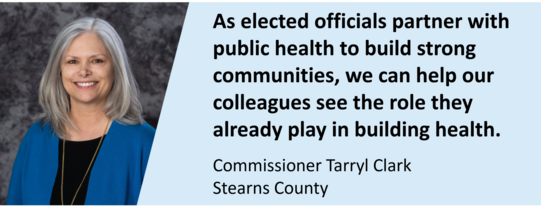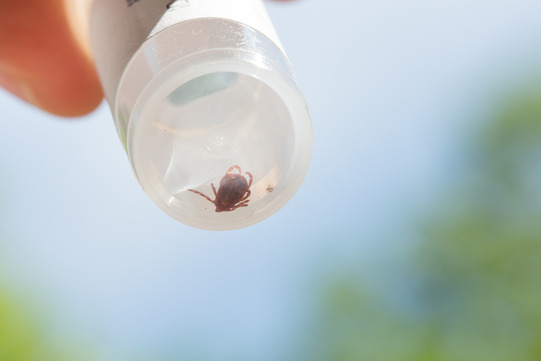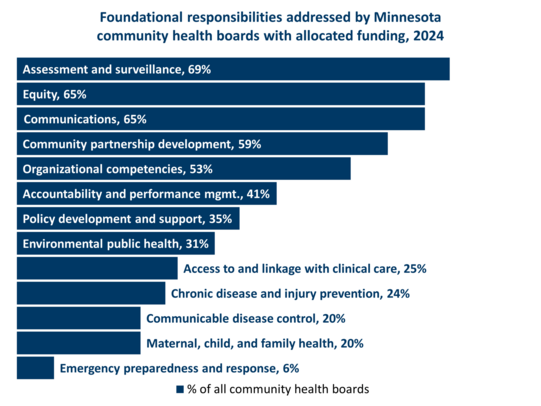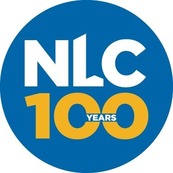|
Public Health
System Transformation Update
A monthly update from the Joint Leadership Team sharing how, together, we're creating a seamless, responsive, publicly-supported public health system in Minnesota

|
|
What does system transformation mean to you?
 We "electeds" might not realize at first that the work we do is very much public health-focused, but it is: Like our public health partners, we’re about connecting, leveraging ideas, finding the right person or group to make a difference.
As electeds and public health professionals partner to build strong communities, we have to help our colleagues see they already play a role in building health, and they don’t even need to change much of what they’re doing.
We can help them have that "aha, wait a minute!" moment, where they see their work connecting back to health—that public health isn’t just vaccines and emergency response, which are very important, but that public health is also about making sure kids are ready for school, using data to drive watershed management, fighting social isolation, soil and water conservation, maternal and child health, working for safe and affordable housing, helping fill food deserts in rural and urban settings.
Last month, Commissioner Tarryl Clark of Stearns County, a member of the Joint Leadership Team for System Transformation in Minnesota, shared her thoughts on how elected officials already support public health even if they don’t yet know it. Read her full column at: May 2024: What does a seamless public health system look like?
|
|
Do you see examples of a seamless, responsive, publicly-supported public health system in your community? Let us know! |
|
 Above, staff collect ticks after "dragging" the woods. Monitoring tick populations from year to year helps us better understand when and where ticks are active, and how many ticks are infected with a disease agent like Lyme disease or Babesiosis.
A seamless, responsive, publicly-supported public health system: What does that mean?
We envision a seamless, responsive, publicly-supported public health system that works closely with the community to ensure healthy, safe, and vibrant communities. This system of state, local, and tribal health departments will help Minnesotans be healthy regardless of where they live. – Joint Leadership Team vision
When we dig into the Joint Leadership Team vision above, what do "seamless," "responsive," and "publicly-supported" mean? What might they look like in a transformed and strengthened governmental public health system in Minnesota?
We considered seamless in last month’s newsletter. Take a look:
May 2024: What does a seamless public health system look like?
This month, we consider "responsive."
We envision a public health system that can react quickly and effectively to today’s opportunities and challenges, plan for tomorrow’s, and use lessons learned from the past to grow stronger and more capable.
What could this mean?
- "We can address root causes, not just fill immediate gaps."
- "We can quickly adapt and adjust to emerging threats, challenges, opportunities."
- "We can meet community needs, especially where there are disparities."
- "We can trust each other’s capacity to partner on work."
- "We can work upstream to address the structural and social drivers of health."
What might this look like?
- Quick and timely data to respond to emerging threats, especially locally
- An agile workforce that can respond to changes, is well-trained, and can see a consistent pathway into public health careers
- A public health workforce that reflects the community it serves
Next month, we’ll think about what it means to have a publicly-supported public health system. Do you have ideas? Let us know!
|
|

In order to do foundational public health work within a local context, Minnesota community health boards need funding that’s flexible and complements communities’ strengths and assets while meeting local opportunities and challenges.
The Minnesota Legislature acknowledged this need, and allocated funding to community health boards to support foundational public health responsibilities in its 2023 session.
This funding is noncompetitive, meaning it’s open for all community health boards in Minnesota. The funding formula prioritizes a board’s Social Vulnerability Index, as well as boards serving smaller populations; a workgroup representing local public health, MDH, and county commissioners (SCHSAC) developed this formula to account for local need and capacity.
Nearly all 51 community health boards have developed a work plan and budget, addressing the following foundational responsibilities:
 Note: Community health boards may have access to additional funding sources for a specific area or capability; if a workplan noted above doesn’t address a specific responsibility, it doesn’t mean the community health board isn’t still working on it with another funding stream. Many community health boards are also addressing more than one responsibility using foundational funding.
What are foundational responsibilities?
Where you live should not determine your level of public health protection. The governmental public health system has a set of foundational responsibilities it stewards, defining what needs to be in place everywhere for Minnesota's public health system to work anywhere, as we work toward a more seamless, responsive, and publicly-supported public health system.
Learn more: Foundational Public Health Responsibilities and Framework


Communications: National League of Cities: Plain Talk About… series
Even if you’re not a city staffer or leader, you may find these resources helpful on communicating clearly and meaningfully, from the National League of Cities.
Communicating about the concepts below can be tricky, because we all bring different values, mindsets, experiences, and beliefs to each concept, as do our colleagues and neighbors. When we can connect with others with clarity and meaning, we can help grow support for public and population health.
Before you draft a presentation, talking points, or an email, try putting yourself in the shoes of the person or people on the other end with these tips and tricks:
Please note: The views expressed in these resources are those of the specific authors and organizations creating these resources, and do not necessarily reflect those of the Joint Leadership Team, its members, or its represented sectors.
|
|
|
What is the Joint Leadership Team?
Three sectors in Minnesota work together to guide the work of transforming Minnesota's public health system, determining what it looks like when a system is equitable and has adequate resources.
This Joint Leadership Team consists of people from: SCHSAC (State Community Health Services Advisory Committee), LPHA (Local Public Health Association of Minnesota), and MDH (Minnesota Department of Health).
Learn more: Joint Leadership Team and Subgroups.
|
|
Contact a specific member of the Joint Leadership Team
Based on the collaborative nature of this work, please direct any questions or feedback to one of the following.
-
Local public health staff and leadership: Please contact your LPHA representatives currently serving on the joint leadership team.
-
MDH staff and leadership: Please contact the MDH staff currently serving on the joint leadership team.
-
SCHSAC members and alternates: Please contact the SCHSAC representatives currently serving on the joint leadership team.
General questions
For general questions, including about funding, grants, and eligible activities: Please contact the MDH Center for Public Health Practice at health.ophp@state.mn.us.
Not sure who to contact?
Visit Ask a Question: Transforming the Public Health System in Minnesota. Joint Leadership Team members review these questions on a regular basis and respond as needed or requested.
|
|
|
|
|